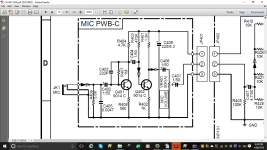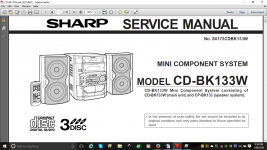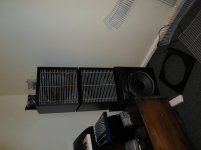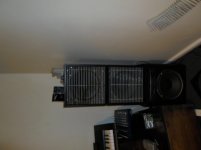hello,
I have salvaged this pcb out off a broken sharp stereo I found in a skip. Im not sure how much voltage to add to pin 1 to get a about a line level signal from pin 2 if it is possible with this part of the circuit?
Also should i use the resistor and coupling shown on the next pcb beside it?
Thanks
Paul d
I have salvaged this pcb out off a broken sharp stereo I found in a skip. Im not sure how much voltage to add to pin 1 to get a about a line level signal from pin 2 if it is possible with this part of the circuit?
Also should i use the resistor and coupling shown on the next pcb beside it?
Thanks
Paul d
Attachments
The decoupling capacitor is rated at 6Volts so 5Volts will be fine. I would use a feed resistor.
thanks i just tried 9v it was making noise, then read your message its clear at 5v,
is a feed resistor a resistor in series with the voltage in or the mic signal in?do you know an idea for ohmns? cheers
In series with the voltage. If you are using 5Volts I would use about 1k. It makes the amplifier stage more stable.
In series with the voltage. If you are using 5Volts I would use about 1k. It makes the amplifier stage more stable.
Thank you
That is a very poor design mic preamp, very dated.
It might have been barely acceptable as a home use mic input to provide some Karaoke function at Junior`s 8th Birthday party and not much else.
He would have been very excited when speaking into a microphone and having his voice coming out of Dad´s speakers 😉
Notice it´s designed for a cheap unbalanced dynamic mic, while modern ones are typically balanced dynamics or electrets.
With such low supply voltage, it will easily overdrive with any reasonable modern mic input, I suggest you replace that 6.3V capacitor with a similar 25V rated one, and feed the preamp clean 15 to 25V DC, the transistors can take that easily and thst biasn system is self adjusting.
But you need *clean* +V (say, coming from a 7815 regulator) because it has no supply rejection, that must have been the origin of the noise you heard.
Wouldn't be surprised to learn that Mic input was by 1/8" jack , the standard for then popular cassette recorders.

It might have been barely acceptable as a home use mic input to provide some Karaoke function at Junior`s 8th Birthday party and not much else.
He would have been very excited when speaking into a microphone and having his voice coming out of Dad´s speakers 😉
Notice it´s designed for a cheap unbalanced dynamic mic, while modern ones are typically balanced dynamics or electrets.
With such low supply voltage, it will easily overdrive with any reasonable modern mic input, I suggest you replace that 6.3V capacitor with a similar 25V rated one, and feed the preamp clean 15 to 25V DC, the transistors can take that easily and thst biasn system is self adjusting.
But you need *clean* +V (say, coming from a 7815 regulator) because it has no supply rejection, that must have been the origin of the noise you heard.
Wouldn't be surprised to learn that Mic input was by 1/8" jack , the standard for then popular cassette recorders.

hello,
It came out of one of theses, i only really rescued for the transformer and a few other bits, then saw the mic amp board.
I replaced all the caps and the ceramic ones for polyester because i wasnt sure how long it had been in the rain. I connected it to a 9v battery (only because its the highest clean power supply i have) and ran it through an old philips hi-z stereo. it sounds alot better now. i will try it with a higher voltage when i salvage another transformer and have time to build one,
Thankyou for the advice
It came out of one of theses, i only really rescued for the transformer and a few other bits, then saw the mic amp board.
I replaced all the caps and the ceramic ones for polyester because i wasnt sure how long it had been in the rain. I connected it to a 9v battery (only because its the highest clean power supply i have) and ran it through an old philips hi-z stereo. it sounds alot better now. i will try it with a higher voltage when i salvage another transformer and have time to build one,
Thankyou for the advice
Attachments
No need for a dedicated supply if you are using it to drive a power amp, you can pull 15V from the existing power amp supply, thatmic preamp eats only a few mA.
good idea, i'm still putting power amps together, they're really just a bass tower, the mic preamp was just to keep my girlfriend happy. the amps almost finished, just need to salvage one more transformer and do a bit of research on grounding ct transformers and filtering so i dont fry myself when im playing
Attachments
- Status
- Not open for further replies.
- Home
- Live Sound
- Instruments and Amps
- help with voltage figure for mic pre-amp circuit




